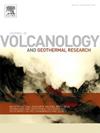Magmatic evolution and timescales of the Naruko caldera system (NE Honshu): Insight from orthopyroxene and quartz mineral zoning
IF 2.3
3区 地球科学
Q2 GEOSCIENCES, MULTIDISCIPLINARY
Journal of Volcanology and Geothermal Research
Pub Date : 2025-08-05
DOI:10.1016/j.jvolgeores.2025.108415
引用次数: 0
Abstract
Silicic magmas from large caldera-forming eruptions often represent crystal-poor melts separated from highly crystalline mush zones under the influence of heat and volatiles. The cascade of magmatic processes from the formation of partially molten crustal zones to the extraction of magma from mush and its interaction with hotter intrusions creates intricate chemical zoning and textures in phenocrysts, reflecting diverse magmatic processes. Understanding the mechanisms and timescales of eruptible magma extraction and storage remains a fundamental challenge in the volcanology. To address this, we present diffusion chronometry from Fe![]() Mg in orthopyroxenes and Ti in quartz from two Pleistocene caldera-forming eruptions at Naruko Caldera, Japan with the Nizaka (73 ka, ∼2.5 km3) and Yanagisawa (45 ka, ∼10 km3) Tuffs. Our findings suggest that both eruptions tapped a broadly similar crustal storage zone, but differences in extraction and localization prior to the eruption influenced the mineral assemblages (e.g., amphibole presence in Yanagisawa but not in Nizaka). Olivine and high-Mg pyroxenes, along with widespread reverse zoning, indicate significant mafic recharge during magma extraction and immediately before eruption. We propose that the Nizaka magma was physically separated from the mush, stored under cooler and less oxidized conditions, and experienced less intrusion by hot magmas, whereas the Yanagisawa magma remained in situ, forming a hotter reservoir that preserved amphibole stability. Despite these differences, the Fe
Mg in orthopyroxenes and Ti in quartz from two Pleistocene caldera-forming eruptions at Naruko Caldera, Japan with the Nizaka (73 ka, ∼2.5 km3) and Yanagisawa (45 ka, ∼10 km3) Tuffs. Our findings suggest that both eruptions tapped a broadly similar crustal storage zone, but differences in extraction and localization prior to the eruption influenced the mineral assemblages (e.g., amphibole presence in Yanagisawa but not in Nizaka). Olivine and high-Mg pyroxenes, along with widespread reverse zoning, indicate significant mafic recharge during magma extraction and immediately before eruption. We propose that the Nizaka magma was physically separated from the mush, stored under cooler and less oxidized conditions, and experienced less intrusion by hot magmas, whereas the Yanagisawa magma remained in situ, forming a hotter reservoir that preserved amphibole stability. Despite these differences, the Fe![]() Mg interdiffusion in orthopyroxenes suggests that both magmas were generated within ∼300 years, with peak accumulation rates occurring within ∼30 years of eruption. Ti diffusion in quartz has a shorter timescale (<30 years), capturing only the final stages of crystallization. Our results support the notion that eruptible silicic magmas might be assembled over short timescales prior to eruption regardless of their volume, which is consistent with the results of previous studies.
Mg interdiffusion in orthopyroxenes suggests that both magmas were generated within ∼300 years, with peak accumulation rates occurring within ∼30 years of eruption. Ti diffusion in quartz has a shorter timescale (<30 years), capturing only the final stages of crystallization. Our results support the notion that eruptible silicic magmas might be assembled over short timescales prior to eruption regardless of their volume, which is consistent with the results of previous studies.
本州东北部鸣子火山口系统的岩浆演化与时间尺度:来自正辉石和石英矿物分带的启示
来自大型火山口形成火山喷发的硅质岩浆在热量和挥发物的影响下,通常代表着从高结晶糊状带分离出来的结晶性差的熔体。从部分熔融地壳带的形成到岩浆从浆液中提取及其与热侵入体的相互作用,一系列岩浆过程在斑晶中形成了复杂的化学分带和结构,反映了岩浆过程的多样性。了解可喷发岩浆提取和储存的机制和时间尺度仍然是火山学的一个基本挑战。为了解决这个问题,我们对日本Naruko火山口形成的两个更新世火山喷发的Nizaka (73 ka, ~ 2.5 km3)和Yanagisawa (45 ka, ~ 10 km3)凝灰岩中的正闪长岩中的稀土和石英中的钛进行了扩散计时。我们的研究结果表明,两次火山喷发都挖掘了大致相似的地壳储存带,但喷发前提取和定位的差异影响了矿物组合(例如,在Yanagisawa存在角闪洞,而在Nizaka没有)。橄榄石和高镁辉石,以及广泛的反向分带,表明在岩浆提取期间和喷发前有明显的镁铁质补给。我们认为,Nizaka岩浆在物理上与泥相分离,储存在较冷且氧化程度较低的条件下,并且较少受到热岩浆的侵入,而Yanagisawa岩浆则留在原位,形成了一个较热的储层,保持了角闪洞的稳定性。尽管存在这些差异,但正闪长岩中的镁铁相互扩散表明,这两种岩浆都是在~ 300年内产生的,峰值积累率发生在喷发后的~ 30年内。钛在石英中的扩散具有较短的时间尺度(<;30年),只捕获结晶的最后阶段。我们的研究结果支持了可喷发的硅质岩浆可能在喷发前的短时间尺度上聚集的观点,而不管它们的体积如何,这与先前的研究结果一致。
本文章由计算机程序翻译,如有差异,请以英文原文为准。
求助全文
约1分钟内获得全文
求助全文
来源期刊
CiteScore
5.90
自引率
13.80%
发文量
183
审稿时长
19.7 weeks
期刊介绍:
An international research journal with focus on volcanic and geothermal processes and their impact on the environment and society.
Submission of papers covering the following aspects of volcanology and geothermal research are encouraged:
(1) Geological aspects of volcanic systems: volcano stratigraphy, structure and tectonic influence; eruptive history; evolution of volcanic landforms; eruption style and progress; dispersal patterns of lava and ash; analysis of real-time eruption observations.
(2) Geochemical and petrological aspects of volcanic rocks: magma genesis and evolution; crystallization; volatile compositions, solubility, and degassing; volcanic petrography and textural analysis.
(3) Hydrology, geochemistry and measurement of volcanic and hydrothermal fluids: volcanic gas emissions; fumaroles and springs; crater lakes; hydrothermal mineralization.
(4) Geophysical aspects of volcanic systems: physical properties of volcanic rocks and magmas; heat flow studies; volcano seismology, geodesy and remote sensing.
(5) Computational modeling and experimental simulation of magmatic and hydrothermal processes: eruption dynamics; magma transport and storage; plume dynamics and ash dispersal; lava flow dynamics; hydrothermal fluid flow; thermodynamics of aqueous fluids and melts.
(6) Volcano hazard and risk research: hazard zonation methodology, development of forecasting tools; assessment techniques for vulnerability and impact.

 求助内容:
求助内容: 应助结果提醒方式:
应助结果提醒方式:


